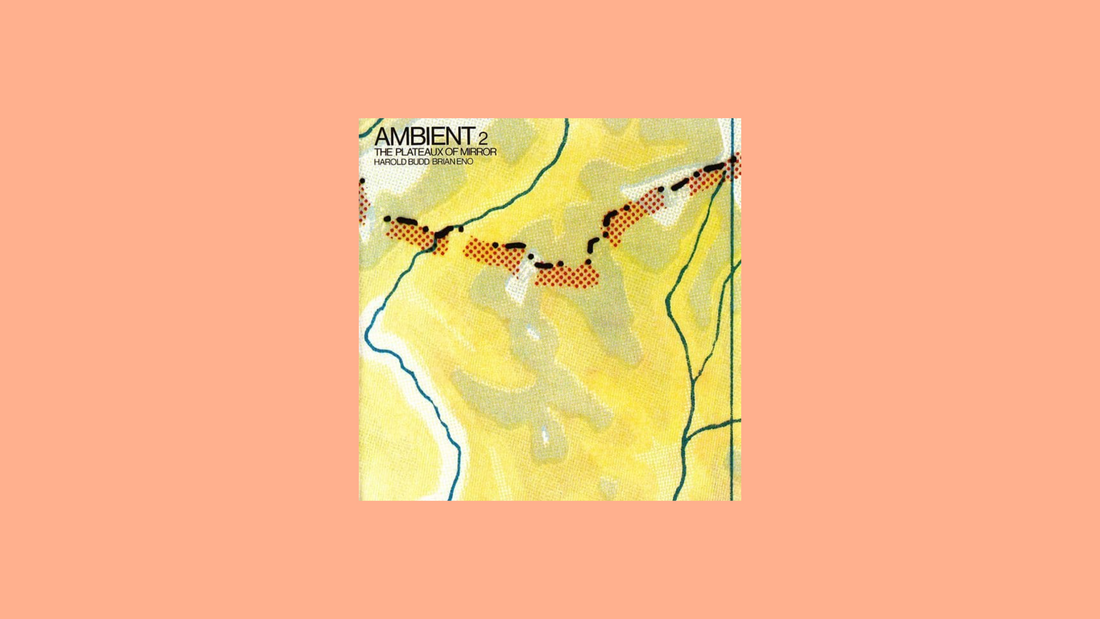
Harold Budd & Brian Eno – The Plateaux of Mirror (1980)
By Rafi Mercer
The first notes sound like ripples, piano tones softened as though heard through water. They arrive slowly, drifting in and out of focus, each one suspended in a haze of resonance. This is how The Plateaux of Mirror begins — not with assertion, but with atmosphere. Released in 1980, the collaboration between Harold Budd and Brian Eno is often described as a cornerstone of ambient music. But unlike Music for Airports, which was built from loops and systems, this album feels personal, even tender. It is a record of presence, of touch, of time stretched thin until sound becomes space.
Harold Budd’s piano is at the centre. Yet it is not piano in the usual sense. Eno recorded it with heavy reverb and processing, turning each note into a bloom that lingers long after the key is struck. The effect is uncanny: a recognisable instrument rendered unfamiliar, its outlines blurred. The notes do not end; they fade into mist. Budd, for his part, plays with restraint, leaving silences wide, allowing resonance to carry meaning. What might have been minimal becomes rich, because the space between notes is alive.
The album consists of ten short pieces, each like a sketch or vignette. They have titles that suggest landscape or dream: First Light, The Silver Ball, An Arc of Doves, Their Memories. These are not compositions in the traditional sense; they are atmospheres. To listen is less to follow progression than to inhabit mood. Each piece feels like a room you step into, furnished sparsely but lit with peculiar, haunting light.
First Light opens the record with slow chords that seem to dissolve even as they are played. The sustain turns harmony into haze, as if time itself were smudged. The Plateaux of Mirror, the title track, introduces more melodic fragments, Budd’s right hand tracing delicate lines over the blur of resonance. It feels like memory half-recalled, precise at the edges but fading in the centre. An Arc of Doves is among the most affecting, its gently descending figures suggesting both grace and melancholy, like birds wheeling in slow motion.
What distinguishes this collaboration is the meeting of Budd’s sensibility with Eno’s technology. Budd was often described, to his irritation, as a minimalist. In truth his music is too emotional, too vulnerable to be reduced to systems. His gift was for simplicity imbued with feeling, for restraint that does not chill but warms. Eno, by contrast, was fascinated by process, by the ways machines and loops could generate texture. Together they found balance: Budd providing the fragile human core, Eno extending it into atmosphere.
The result is an album that feels both ancient and futuristic. The piano is recognisable, but transformed into something otherworldly. The pieces are modern recordings, but they evoke medieval chant, impressionist colour, even natural phenomena — water, wind, light. It is no coincidence that many listeners describe the music in visual terms. These are not songs but images in sound, plates of memory held up to the light.
To play The Plateaux of Mirror is to alter the room. The music is quiet, almost fragile, yet it fills space in ways louder records cannot. It sharpens attention to subtlety: the decay of a note, the overlapping of tones, the texture of silence. It is music that demands no response yet heightens perception. Many ambient records aspire to this balance — ignorable if you choose, transformative if you attend — but few achieve it with such grace.
Culturally, the album reinforced the idea of ambient music as not only functional but emotional. Where Music for Airports proposed a concept, The Plateaux of Mirror offered intimacy. It became a reference point for generations of ambient and neoclassical composers: the idea that simplicity could carry depth, that mood could be meaning. Its influence can be heard in contemporary piano minimalism, in film scores, in sound art. But influence aside, its staying power lies in its delicacy. Few records risk so little adornment, and fewer still succeed.
Listening today, forty years on, the record feels almost outside of time. Its textures do not date, because they were never of a moment. They exist in suspension, as relevant now as then. Play it in the morning and it feels like dawn light. Play it late at night and it becomes memory. It is music that adapts, not by changing, but by reflecting the state of the listener.
Perhaps the most remarkable quality of The Plateaux of Mirror is its humility. It does not announce itself as masterpiece. It does not demand recognition. It simply exists, offering space, offering calm, offering beauty without insistence. And that, perhaps, is why it continues to matter. In a world of noise and assertion, its quietness becomes radical.
Harold Budd would go on to make many more records, some again with Eno, but this remains his most enduring collaboration. It captures not only the sound of two artists but a philosophy: that music need not strive for dominance to matter, that atmosphere itself can be profound. The Plateaux of Mirror is not spectacle. It is sanctuary.
Rafi Mercer writes about the spaces where music matters. For more stories from Tracks & Tales, subscribe, or click here to read more.














